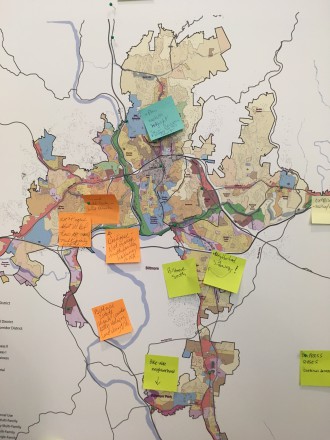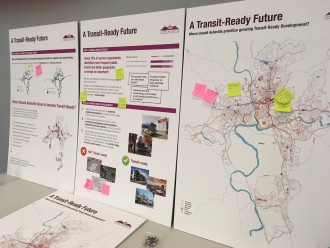Residents of South Asheville expressed concerns about traffic, infrastructure, development, affordable housing, transit, wages and the environment in a public input session held at noon on Wednesday, Dec. 7 at the South Buncombe Library. The session was one of five hosted in different parts of the city on Dec. 6 and 7 by the city’s planning and urban design department as part of the comprehensive plan process.
Projected to span a year and a half, the comprehensive planning effort is now in its fifth month. When complete, said consultant Roger Weber of New York-based Skidmore, Owings & Merrill, the comprehensive plan will outline the city’s priorities and put forward a “unifying vision” to guide future development and policymaking.
According to Weber, previous public engagement opportunities have included an online survey that garnered 700 responses, a public input workshop in October and advisory and focus groups.
Weber didn’t mention the “plan on a page” effort that preceded the official kickoff of the process. Thirty city neighborhoods submitted plans that detail their neighborhood’s concerns and goals in July.

Planning and Urban Design Director Todd Okolichany invited attendees to start the session by introducing themselves to those sitting around them. Then the city’s consultants led a polling activity that used individual keypad remotes to collect responses to 12 broad questions about residents’ priorities and expectations for city services.
Keeping track of the audience’s responses was difficult for observers. The consultant operating the laptop presentation, Glenn Walters of Design Workshop in Asheville, repeatedly clicked quickly to the next slide when the responses appeared on the screen, prompting attendees to ask that he re-show some sets of responses. Walters said it was not possible to move backward in the presentation. Stacy Merten, the city’s project manager for the comprehensive plan, said she was photographing each slide and the software would collate the responses. She said she would post the questions on the city’s webpage for the comprehensive plan.
The first three questions probed views on the relationship between development, density and transit.
To a question exploring the importance of the city’s role in promoting an adequate supply of housing at all income levels, 56 percent of those attending said the city’s role is “very important.”
Most said they would prefer either higher city taxes to support expanded city services or more services financed by user fees.
Walkability, greenways and opportunities for active lifestyles topped the attendees’ priorities for ways the city can promote residents’ quality of life.
In advancing equity for all city residents, attendees said tourists should pay more for their use of city services and facilities and neighborhoods should have a voice in shaping their own futures.
Throughout the polling activity, residents asked for clarification about the intent of the questions and how the polling data will be used. “This isn’t a perfect technology,” conceded Weber, saying the exercise was part of an early stage in the planning process and that many more opportunities for input and comments will be available.

Vijay Kapoor, a South Asheville resident who has been active in organizing residents in the area, pointed out that none of the questions dealt with infrastructure. “Traffic is a big problem down here. Where is that addressed?” he asked. Weber urged those with concerns about infrastructure to note them on their comment cards.
At the end of the formal presentation and discussion, attendees were invited to circulate among stations around the room dedicated to topics like transit, open space, land use and residents’ visions for the future of the city.
After the meeting, Kenilworth’s Teddy Jordan expressed concern about how the input in the individual neighborhood plans will be incorporated into the overall vision. Kenilworth’s plan took five months to develop, she said, and generated 4,400 comments. Jordan said she’s volunteered to help tally the data and summarize the themes from the neighborhood plans, but so far the city hasn’t accepted her offer or explained how the information will be processed. “I’m hoping the opportunity has not totally been missed,” she said.
Joe Fioccola, a resident of central Asheville, said he had attended the sessions in North, West and central Asheville as well as the South Asheville meeting. Of the four sessions, he said, “North was pretty tough. Several people there were very critical of the city’s questions.”
After the meeting in South Asheville, the city’s team had one more meeting, this time in East Asheville, to round out the public input component of this stage in the comprehensive planning process.



“Traffic is a big problem down here. Where is that addressed?”
Maybe Mr Kapoor should raise his concerns with the relevant authorities in the county and Biltmore Forest, not that the latter will give him the time of day.
Every dollar paid to the planners is a dollar diverted from human needs like shelter. People are freezing to death for these planners fat paychecks. They are nosebreathing monsters.